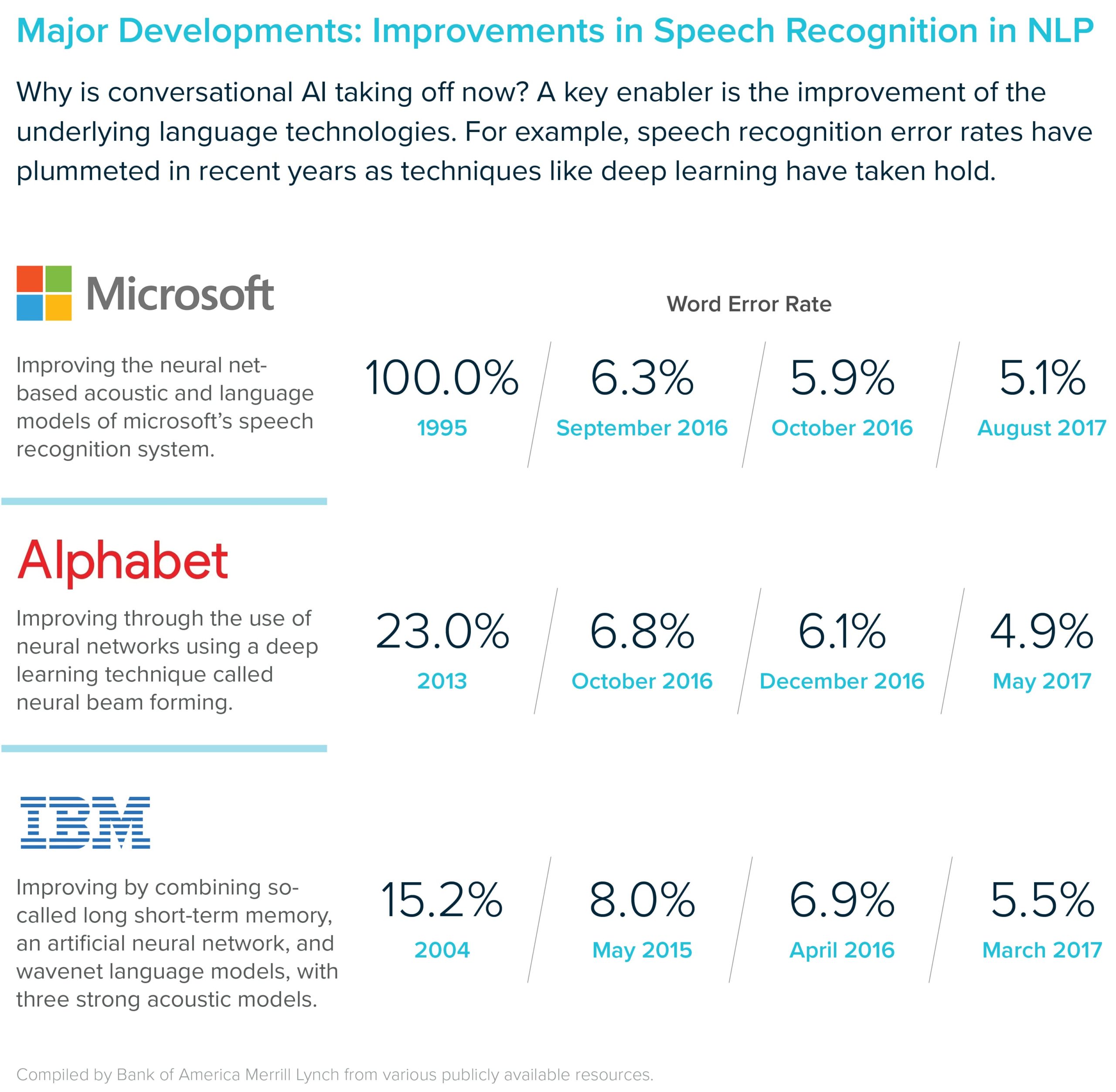
What Is Conversational AI?
Have you ever stopped to think about how inefficient business communication can be? I recently had the common but infuriating experience of trying to change an airline reservation. After being stuck on hold, I eventually had to provide the same personal details no fewer than three times. Meanwhile the representatives had to stick to their script despite my increasingly frustrated tone of voice. Eventually I got disconnected and — you guessed it — had to start all over again.
That’s one frustrating experience that we can all relate to, but there are plenty of others. Just think about all of the information in knowledge bases or employee handbooks that gets painstakingly compiled but can’t easily be found. Or how about all of the conversations that never even get a chance to happen because they’re too expensive or labor-intensive? I’m talking about things like reaching out to all of your past customers individually to tell them about a new product, or coaching a new manager before each employee review.
Although communication is at the heart of a business, business-to-customer and employee-to-employee interactions are full of missed opportunities. The good news is that we’ve reached the point where we can use machine capabilities to understand and produce human language through an approach called conversational AI. And, as we’ll see, that’s going to make a huge difference in how you build relationships with customers and enable your employees to be their best.
Done well, conversational AI can address all of the issues I cited above, and more, by making personalized conversational experiences scalable. Plus, it can provide a mechanism for them to actually get better over time. And the time to implement conversational AI is now. Given the ubiquity of voice and chat messaging platforms, your business has no choice but to adopt conversational AI. Just consider the following statistics:

In the rest of this post, I’m going to explain exactly what conversational AI is and why it’s so important. I’ll also talk about the main types of conversational AI applications, highlight some companies that have used conversational AI to transform their businesses and give you some tips for getting started.
What Is Conversational AI?
As I mentioned earlier, conversational AI is about using machine capabilities to understand and generate human language. Let’s look at both of those aspects in a bit more detail:
Language Understanding
Language understanding is when a machine can take a piece of content that a person has produced (in either a voice or text format) and determine a number of things:
- Is it natural language?
- What language is it?
- What people or places are mentioned?
- Is it a question or a statement?
- How does the speaker feel about the topic?
Knowing these and other things about the content will help your system decide how to handle it. For example, a chatbot (a computer software program designed to simulate human conversation via text or audio) needs to have a basic understanding of individual sentences before it can choose a response. It’s worth mentioning that this isn’t “understanding” in quite the same way that a person understands language. That’s because the machine is looking for statistical patterns that it has learned from training on large datasets. That said, for many applications, the quality of the results is nearly as good as — and in some cases even better than — human performance.
Language Generation
Language generation involves two main tasks: natural language generation and text-to-speech. Natural language generation means creating sentences in natural language from structured data. This can be as simple as using a set of rules or templates to come up with a chatbot response, or as complex as analyzing financial data to look for anomalies and then generating a memo to explain them. In the case of voice interfaces, text-to-speech technology can then turn this text into audio.
In short, conversational AI capabilities can emulate many of the things humans do when we’re having a conversation, reading or writing. Next, I’ll talk about why these capabilities can change the way we interact with technology.
Why Is Conversational AI Important?
If you’re wondering why conversational AI matters, let me break it down for you. From punch cards to keyword searches, machine-to-human communication has historically been rudimentary compared to the richness of human language. However, recent advances in deep learning have driven error rates down across a wide range of language technologies.

That means that it’s now possible (or soon will be) to interact with your computer (or even your toaster, car or thermostat) using everyday language. When conversational AI works, it taps into our social instincts in a profound way. For example, people:
- Can easily become emotionally attached to conversational agents.
- Are sometimes willing to share personal information with chatbots — and sometimes even prefer to bring up sensitive topics with a chatbot over a human to avoid being judged.
- Make the time to greet and thank chatbots as they would another person, even though they know that they’re interacting with bots.
In addition to being natural, conversational AI applications benefit from the fact that they can easily exist in the environments where we already spend the bulk of our time. Text interfaces, for example, can reach users in widespread messaging apps like Facebook Messenger and WhatsApp, which hundreds of millions of people use constantly. Just consider that five of the top ten apps of all time are messaging apps and that 75 percent of smartphone owners make use of chat.
Voice interfaces can go beyond even that, reaching users when they’re driving, in the kitchen, or walking around. While users may differ in their level of technical sophistication, nearly everyone’s mastered human language. That means that conversational interfaces have the potential to reach a wider audience than many technologies.
Anyone who’s used chatbots or voice-activated interfaces is aware that the technology is far from perfect, and results can be humorous or even offensive. Still, conversational AI algorithms and design are becoming more sophisticated and better training data is becoming available. This means that jarring experiences will be increasingly less common. We’ll be able to chat with these systems much like we might engage with a friend or colleague. As a result, you’ll be able to build increasingly personal relationships with customers and provide a new set of capabilities to your employees via conversational AI experiences.
In other words, human-computer interactions are increasingly being realized as conversations, and every conversation is an opportunity to engage and learn. The good news is that although general conversational AI that can converse on all topics is still a significant leap away, high-quality conversational AI targeted at specific use cases or domains is becoming easier to implement.
How Is Conversational AI Applicable to My Company?
So how can you make use of conversational AI to change the way communication happens in your business? There are two primary types of conversational AI applications that are likely relevant:
1. Conversational agents allow you to have a conversation with an automated system in natural language via a voice or text interface, such as Amazon Echo or a chatbot. Depending on the use case, the system may be fully automated or have a human in the loop for particularly challenging, sensitive or high-value conversations.
2. Conversational enhancement uses AI to improve the quality or efficiency of conversations between humans. For instance, when Google suggests a response to an email, when Slack learns who your company’s experts on a particular topic are or when automated systems block online bullying.
Both of these types of conversational AI can help your company in two key domains:
1. Customer Experience and Brand Building
The first is customer experience and brand building. Deploying a well-designed bot on a popular platform lets you build relationships with prospects and customers in a personalized, positive way that would be cost-prohibitive without automation. Meanwhile, you’re collecting an ever-renewing and -expanding set of data that can help you understand your users on an individual level in a much more detailed fashion than with traditional techniques. Customer support chatbots, for example — usually with humans in the loop where necessary to ensure quality — can provide customer service and issue resolution with reduced response times and higher satisfaction.
Examples:
 |
OCBC Bank’s mortgage loan officers were losing potential customers due to confusion about their products, while also spending valuable staff time cultivating leads that turned out to be low quality. They partnered with Cognicor to develop a chatbot called Emma to inform and help qualify potential leads. Six months after launch, lead conversion rates had improved threefold. |
 |
Tommy Hilfiger has been an early adopter of building customer relationships through conversational AI, with consumers returning to its Facebook Messenger chatbot an average of three times. When the retailer made their NYC Fashion Week collection available via chatbot, it drove 3.5 times as much revenue there as through other digital channels. |
 |
Autodesk wanted to improve the efficiency of its customer service function and introduced a chatbot built on IBM Watson to handle basic requests that didn’t require a human agent. The results were resounding: resolution times went from a day and a half to just over five minutes. Meanwhile the cost of handling an issue went down by over 90 percent. |
2. Employee Experience
Although less commonly discussed, conversational AI also has compelling applications for employee experience. Recruitment-focused chatbots can give job candidates a personalized introduction to the company and facilitate the seamless scheduling of interviews. For current employees, conversational interfaces can automate many internal communication processes and provide employees with an efficient and friendlier way to access information they’d otherwise have to search for in handbooks or knowledge bases, or track down from colleagues. Finally, employee development and coaching processes built on conversational AI have started to show promise.
Examples:
 |
Mya is an AI recruiter that engages candidates throughout the recruiting process, decreasing the time it takes to move from candidate to hire by 70 percent. | |
 |
Cogito listens in on sales calls and provides real-time coaching to employees on their tone, empathy and whether they’re interrupting too much. Humana was able to improve its Net Promoter Score by 28 percent by adopting Cogito in its customer care. | |
 |
SkipFlag analyzes conversational data from a variety of platforms and uses the results to automatically build a constantly updating knowledge base, to answer similar questions, and to identify your company’s experts on particular topics. |
How Can My Company Get Started with Conversational AI?
If you want to adopt conversational AI, the first step is to start using it. Your employees will start grasping the potential most readily if they’re making use of conversational AI applications themselves. Fortunately, there are a number of relatively easy ways you can bring conversational AI into the workplace relatively quickly: Adopt Howdy for your standups, try Alexa for Business, or try using AI personal assistants to automate meeting scheduling.
Second, identify some use cases with your own customers or employees where conversational AI merits more investment. Look for cases where you can meet some of the following user needs:
- Reducing friction. Use conversational AI to simplify complex workflows by turning them into a natural chat.
- Convenience. Embrace voice to reach your users when they need to be hands-free, or engage them in a messaging app they already use.
- Decision support. Adopt conversational AI to walk users through a decision or task that might feel overwhelming.
- Trust. Leverage conversational AI to develop a relationship with your users over time.
Our guide on The 9 Principles of Conversational AI goes into more detail about how to develop your conversational AI roadmap.
Once you’ve selected one or a couple of use cases to get started with, you’ll need to put together a team and select tools. Fortunately, due to the maturity of existing communication and NLP platforms, you can usually leverage your existing engineering team. Assign marketing to take a key role as well, ensuring the persona and content of your application are aligned with your brand.
As you expand your conversational AI offerings, you may want to think about adding more specialized roles to your hiring roadmap: a computational linguist to tweak NLP models, a full-time designer to work on personas, a writer to produce engaging content, or a data engineer to extract value from the conversational data you’re collecting. You can also consider getting this expertise from a third-party consultancy, but if conversational AI is core to your business, you may eventually want to bring some of this in house.
For tools, you’ll first want to decide if you’re going for a voice- or text-based experience. As a rule of thumb, if you’re developing an experience that will mostly be used when people are hands- or eyes-free, voice is the obvious answer. Otherwise, you’ll want to get started with chat. Then, choose a voice or text platform to reach your users based on where they already interact. Don’t try to build your own messaging app or voice interface from scratch, and don’t expect your users to switch platforms for your functionality.
If you have a significant user base spread across platforms, consider using a cross-platform framework like the Microsoft Bot Framework to allow you to deploy with a wider scope. Note, however, that you may have access to more limited features than if you choose a single platform approach. When you’re starting out, you can similarly leverage off-the shelf natural language processing tools such as LUIS or Amazon Comprehend and design tools such as Botmock to accelerate your development process.
As you begin to roll out conversational AI applications, there are some common pitfalls you should avoid. First, be sure that your experience gets the eight essential components of conversational AI right. Second, don’t blow your first chance to introduce conversational AI to your customers or employees by overpromising. Instead, start with a narrow, clearly communicated scope where you can really deliver a great experience, and don’t worry about handcrafting some aspects of the experience to get there. Over time, you can add features and coverage for more use cases.
As you turn away from this post and go back into your workday, I hope you’ll carry with you an eye for where communication in your business could use improvement. Think about where conversational AI technologies could help you better connect with customers or employees. Notice inefficiencies that are ripe for conversational AI solutions.
In the meantime, stay tuned for more articles covering conversational AI topics. As the landscape evolves, I’ll also be regularly updating this post to keep it current. I’d love to hear from you via Twitter (I’m @jbrenier) and look forward to continuing the conversation.
Want to Learn More About Conversational AI?
We’ve put together a couple of the most useful resources for your team to start thinking about where conversational AI fits in:
For technologists
- Get a quick overview of chatbot platforms you should know in Top 10 Chatbot Platforms.
- Learn about the language technologies that underlie conversational AI in How to solve 90% of NLP problems: A step-by-step guide.
For product leaders
- Learn about how to put together a team to make conversational AI a reality with our Building Conversational AI Teams playbook.
- Find out how to measure performance for conversational AI applications with Tracking the Right Chatbot KPI.
- Learn what separates a dumb bot from conversational AI in How to Build A Better Bot.
- Get a broad overview of the industry and what to expect this year in The State of Conversational AI in 2018 and Beyond.
For designers
- From Google comes a solid guide to the most important aspects of designing conversational AI experiences: The Conversational UI and Why It Matters.
- Understand common design patterns for conversational AI interfaces by checking out Everyone’s Guide to Designing Great Conversational Interface Experiences.
- Learn how to start a conversation and keep it on track with Simple Rules for Conversational Interfaces.
- Amazon’s guide to designing scripts and dialogue flow for voice is worth a look and is called Designing for Voice.
- From UX Collective comes a carefully curated set of articles covering top issues in Conversational AI design named Chatbots & Conversational UI.
For marketers
- If you want to understand how conversational AI should change your marketing strategy, take a look at What is Conversational Marketing?
- Understand who’s using conversational marketing already, and how with State of Conversational Marketing.
- From Automat.ai, get the inside scoop on some well-known conversational AI applications in their Conversational AI Case Studies.
- Get a summary of the major messaging platforms and their respective pros and cons in How to Choose a Messaging App for Your Marketing Campaign.
For customer support and community managers
- Get real talk from Chetan Dube of IPSoft about what you should and shouldn’t expect from a chatbot in Cognitive Chatbots in Customer Service: Beyond the Hype —
Does Your Company Need a Chatbot? - Check out this great overview of the most common metrics for assessing your customer service focused conversational AI initiatives in 8 Ways to Measure Chatbot Program Success.
For HR
- Want to know about the opportunities and challenges your HR team should be thinking about? Have a look at 7 Ways Chatbots are Disrupting HR.
- Take a peek at these thought-provoking examples of conversational AI throughout the employee lifecycle in The invasion of Chatbots (HR Trends)
Read more like this
KumoVC: Turning Venture Data into Instant Predictions with KumoRFM
Originally published on Kumo.ai’s blog. In this technical blog post, Azin and…
Verticalized Voice AI – The Next Application Layer Shift
Every decade or so, a new interface reshapes not just how people…
From Static to Adaptive: Scaling AI Reasoning Without the Waste
2025 has been the year of reasoning models. OpenAI released o1 and...